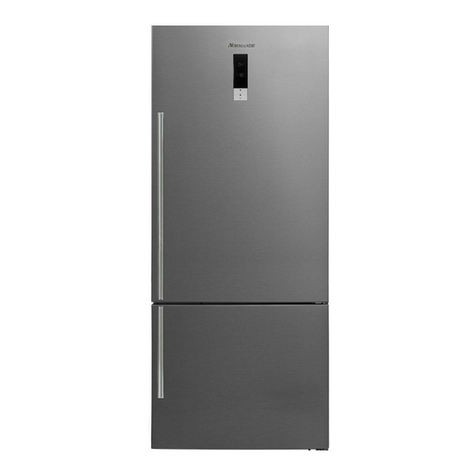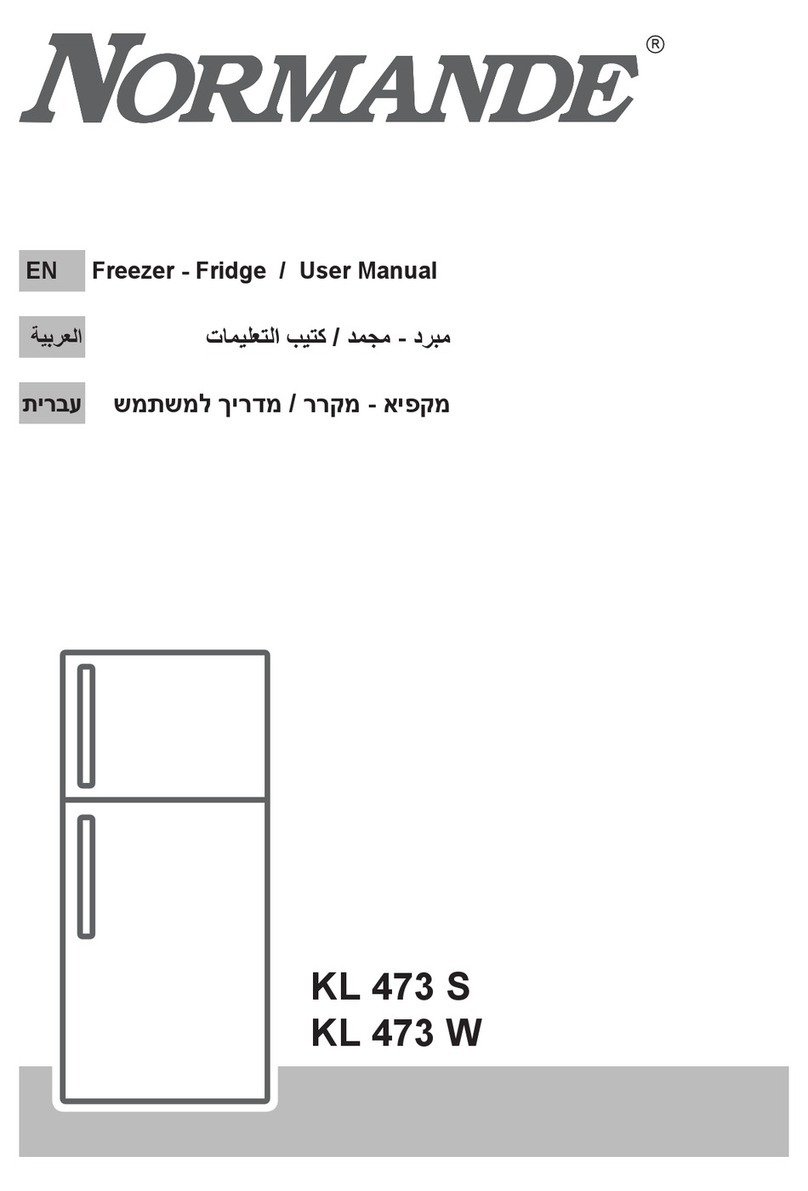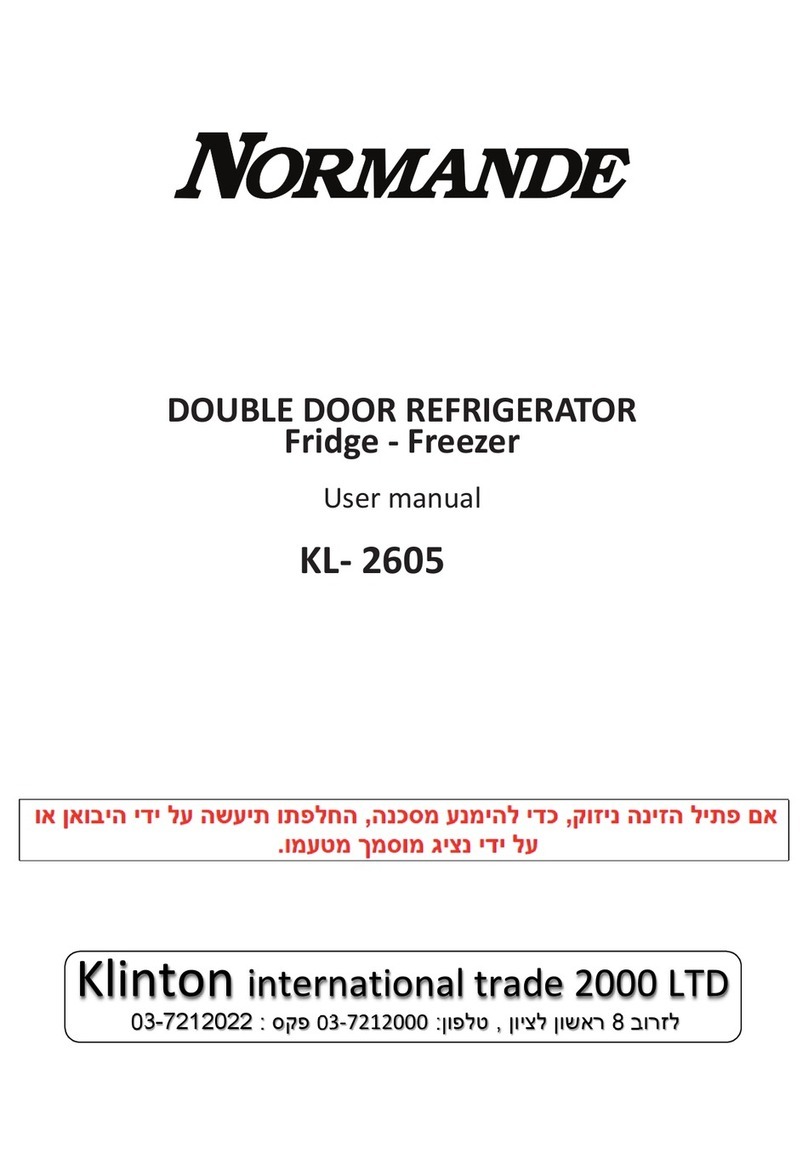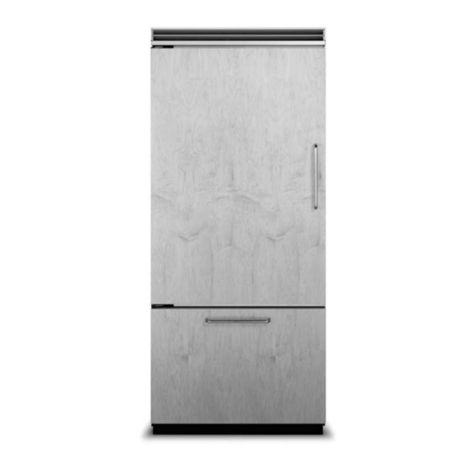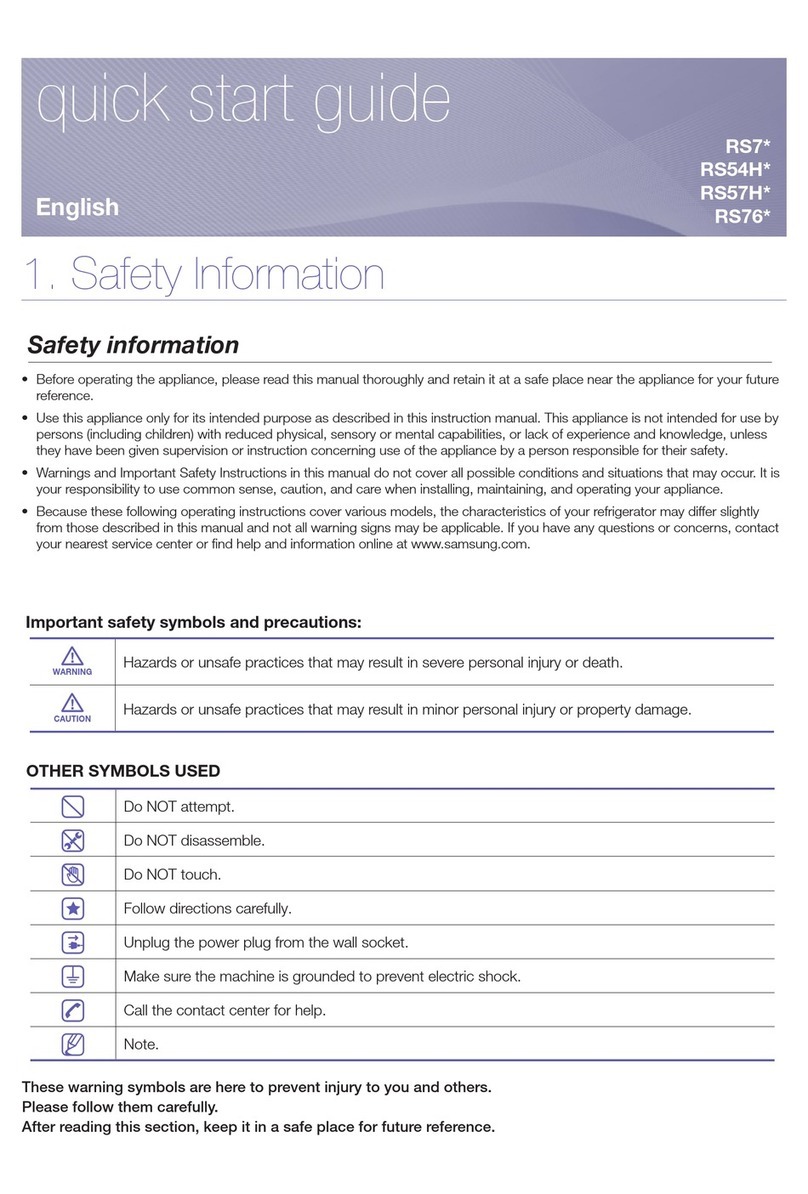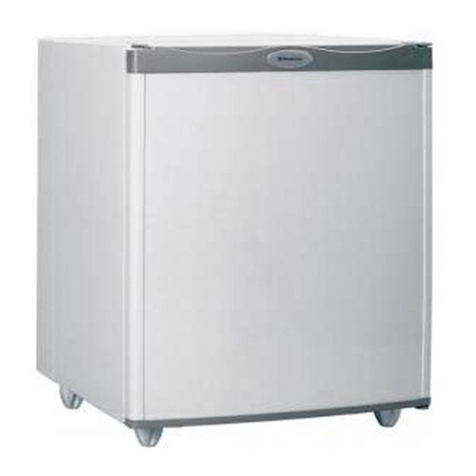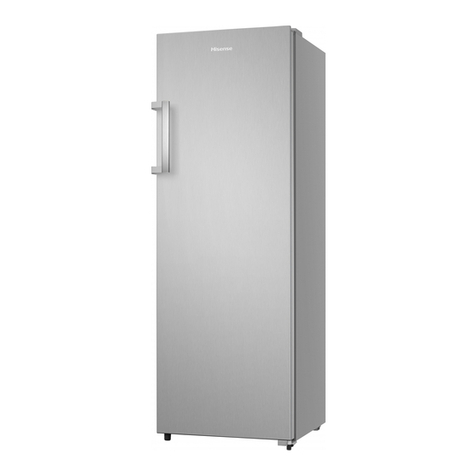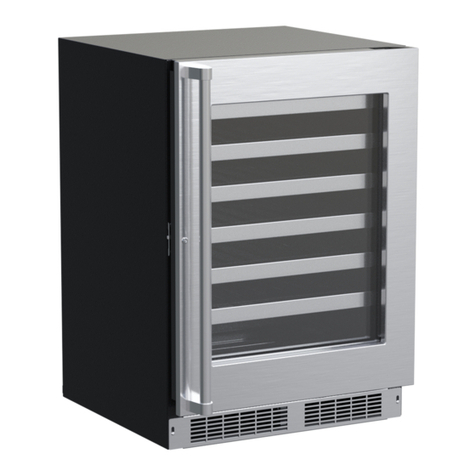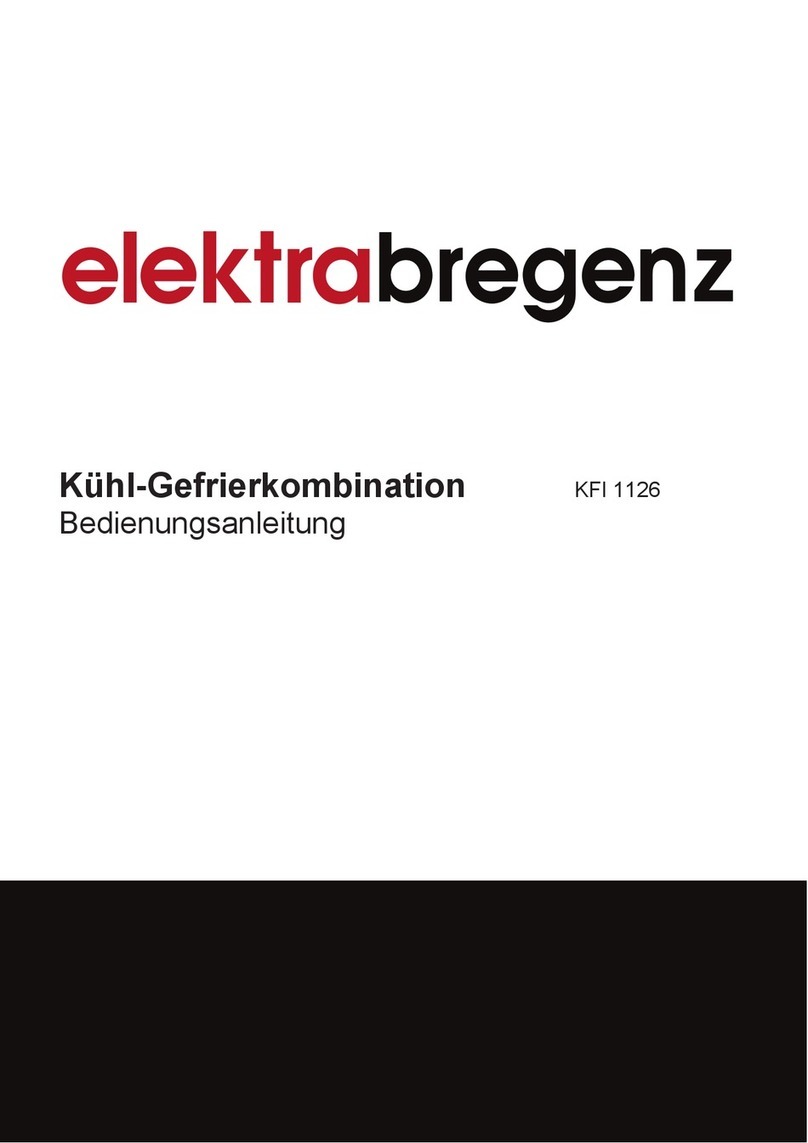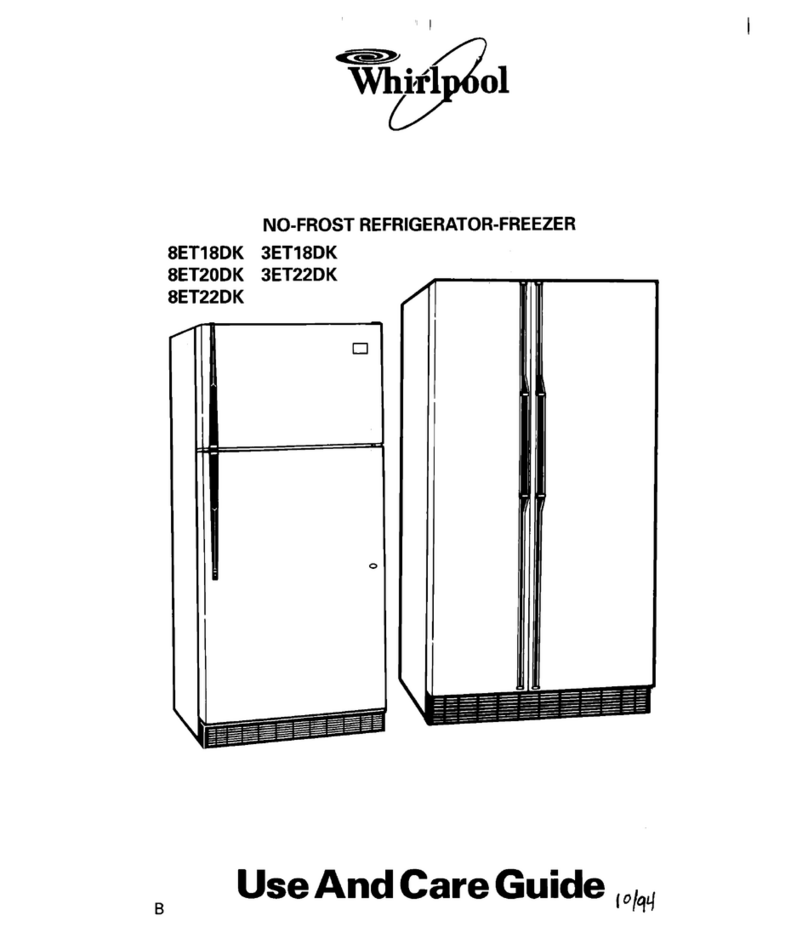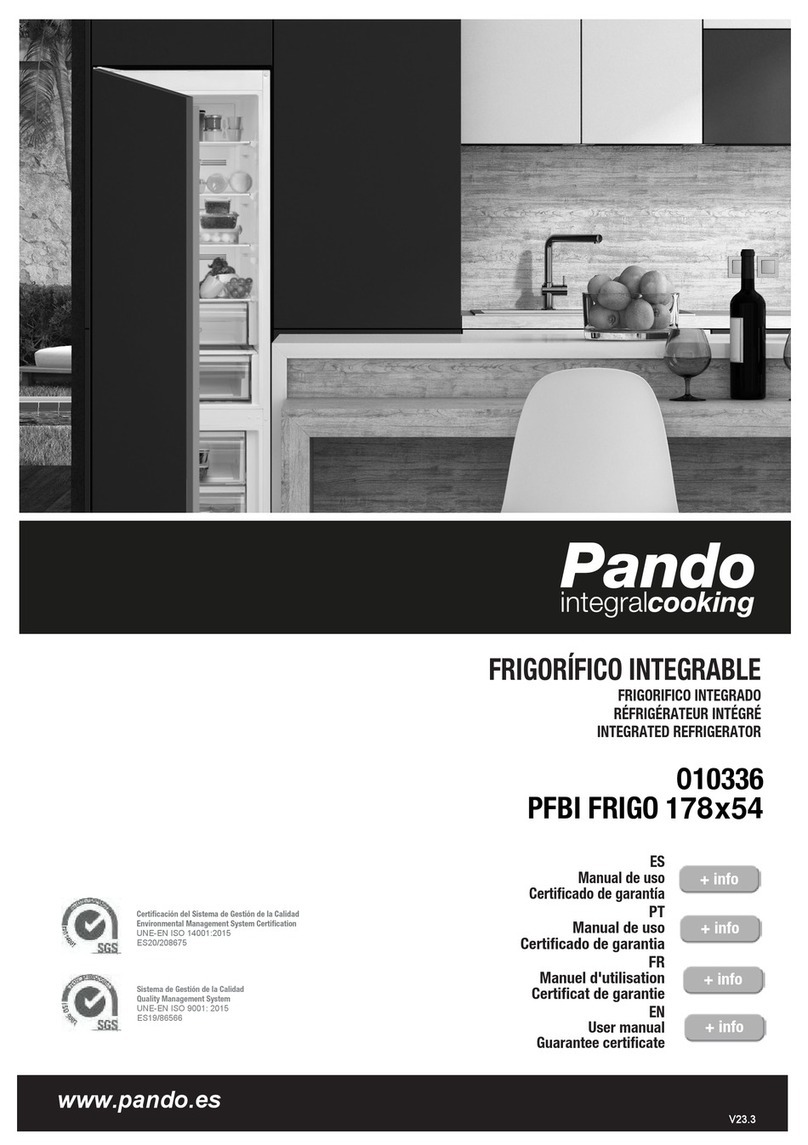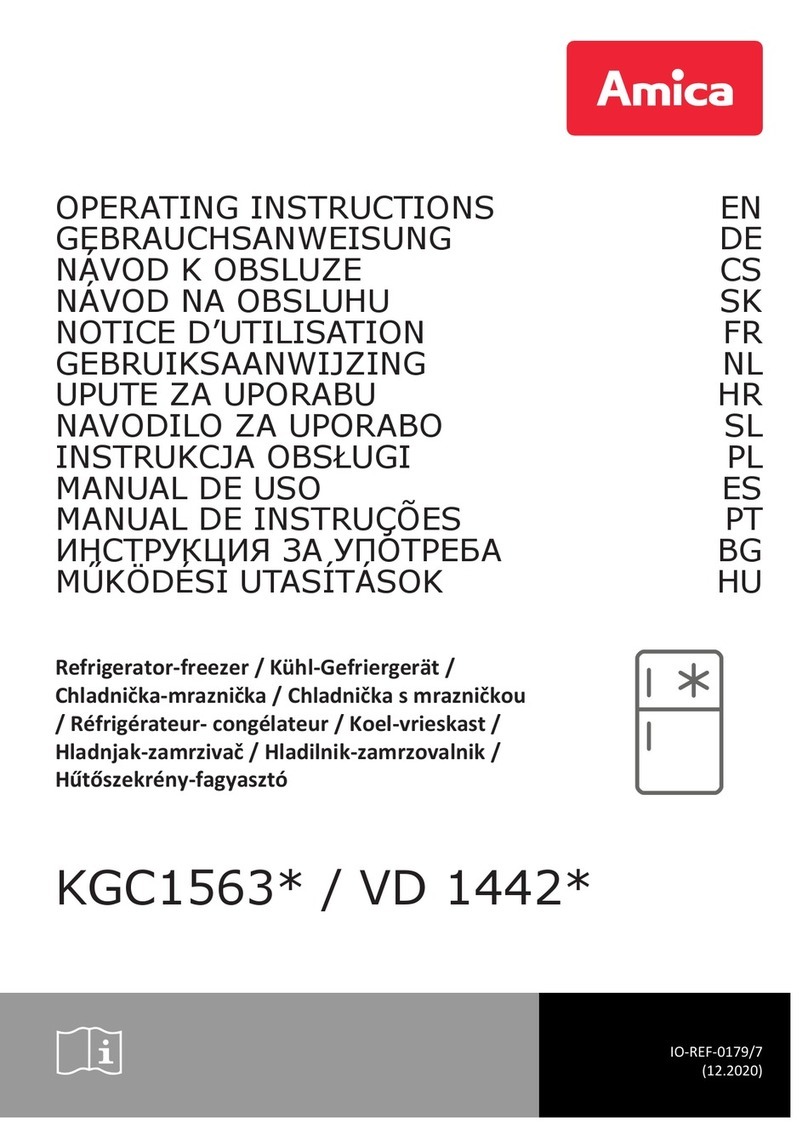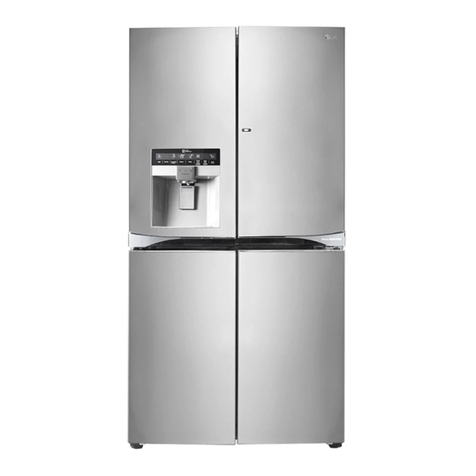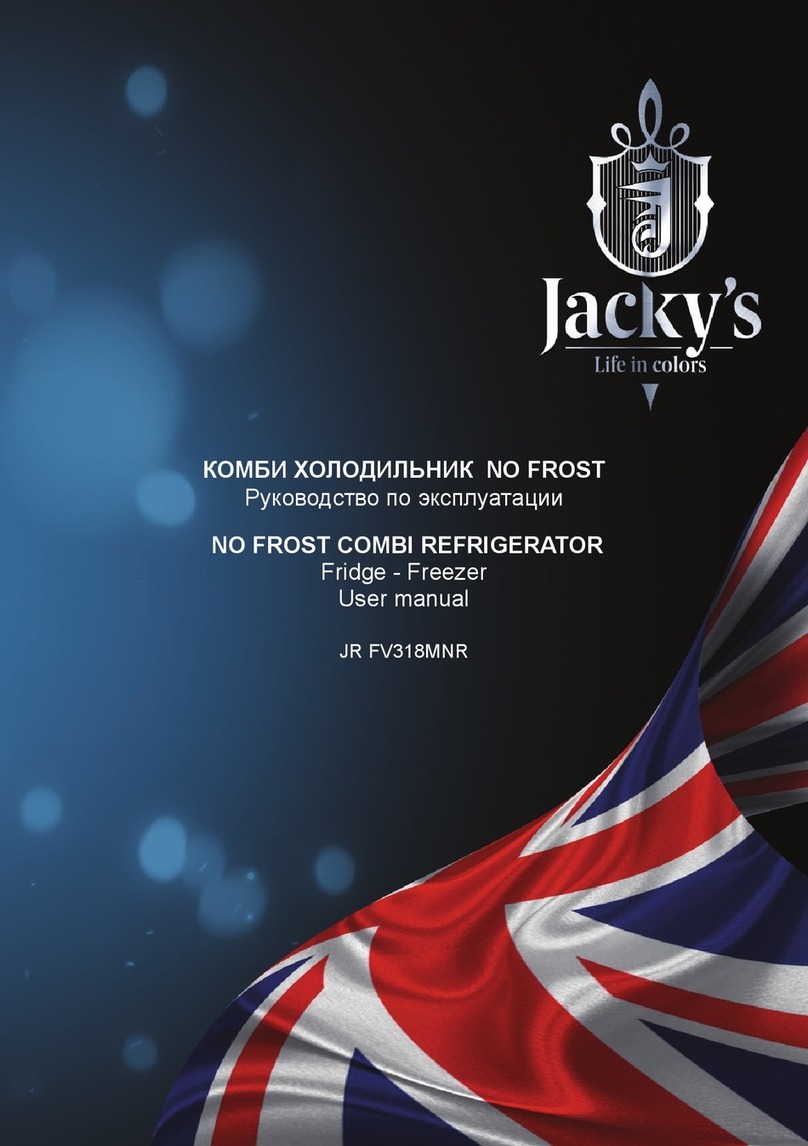Normande KL 55100BG User manual

Klinton
international trade 2000 LTD
בורזל8 :ןופלט , ןויצל ןושאר03-7212000 : סקפ03-7212022
KL 55100BG
NO FROST REFRIGERATOR
Freezer - Fridge
Inruction booklet


EN -1-
Index
BEFORE USING THE APPLIANCE .................................................................. 2
Old and out-of-order fridges .........................................................................................5
Safety warnings ............................................................................................................5
Inalling and operating your fridge...............................................................................6
Before Using your Fridge..............................................................................................7
THE VARIOUS FUNCTION AND POSSIBILITIES........................................... 7
ARRANGING FOOD IN THE APPLIANCE ..................................................... 11
CLEANING AND MAINTENANCE................................................................... 13
TRANSPORTATION AND CHANGING OF INSTALLATION POSITION ..... 15
Repositioning the Door...............................................................................................15
BEFORE CALLING YOUR AFTER SALES SERVICE .................................. 15
Tips for saving energy ................................................................................................17
THE PARTS OF THE APPLIANCE AND THE COMPARTMENTS ............... 18
FIRE !
Warning; Risk of re / ammable materials

EN -2-
PART- 1.
General warnings
WARNING: Keep ventilation openings, in the appliance
enclosure or in the built-in structure, clear of obstruction.
WARNING: Do not use mechanical devices or other means
to accelerate the defrosting process, other than those
recommended by the manufacturer.
WARNING: Do not use electrical appliances inside the food
storage compartments of the appliance, unless they are of the
type recommended by the manufacturer.
WARNING: Do not damage the refrigerant circuit.
WARNING: When positioning the appliance, ensure the
supply cord is not trapped or damaged.
WARNING: Do not locate multiple portable socket-outlets or
portable power supplies at the rear of the appliance.
WARNING: In order to avoid any hazards resulting from the
instability of the appliance, it must be xed in accordance with
the following instructions:
If your appliance uses R600a as a refrigerant (this information
will be provided on the label of the cooler) you should take
care during transportation and installation to prevent the cooler
elements from being damaged. R600a is an environmentally
friendly and natural gas, but it is explosive. In the event of a leak
due to damage of the cooler elements, move your fridge away
from open ames or heat sources and ventilate the room where
the appliance is located for a few minutes.
While carrying and positioning the fridge, do not damage the
cooler gas circuit.
Do not store explosive substances such as aerosol cans with
a ammable propellant in this appliance.
BEFORE USING THE APPLIANCE

EN -3-
This appliance is intended to be used in household and
domestic applications such as:
- a kitchen areas in shops, oces and other working
environments.
- farm houses and by clients in hotels, motels and other
residential type environments.
- bed and breakfa type environments;
- catering and similar non-retail applications.
If the socket does not match the refrigerator plug, it must be
replaced by the manufacturer, a service agent or similarly
qualied persons in order to avoid a hazard.
A specially grounded plug has been connected to the power
cable of your refrigerator. This plug should be used with
a specially grounded socket of 16 amperes. If there is no
such socket in your house, please have one installed by an
authorised electrician.
This appliance can be used by children aged from 8 years and
above and persons with reduced physical, sensory or mental
capabilities or lack of experience and knowledge if they
have been given supervision or instruction concerning use
of the appliance in a safe way and understand the hazards
involved. Children shall not play with the appliance. Cleaning
and user maintenance shall not be made by children without
supervision.
• Children aged from 3 to 8 years are allowed to load and
unload refrigerating appliances. Children are not expected
to perform cleaning or user maintenance of the appliance,
very young children (0-3 years old) are not expected to use
appliances, young children (3-8 years old) are not expected
to use appliances safely unless continuous supervision
is given, older children (8-14 years old) and vulnerable
people can use appliances safely after they have been

EN -4-
given appropriate supervision or instruction concerning use
of the appliance. Very vulnerable people are not expected
to use appliances safely unless continuous supervision is
given.
If the supply cord is damaged, it must be replaced by the
manufacturer, an authorised service agent or similar qualied
persons, in order to avoid a hazard.
This appliance is not intended for use at altitudes exceeding
2000 m.
To avoid contamination of food, please respect the
following instructions:
Opening the door for long periods can cause a signicant
increase of the temperature in the compartments of the
appliance.
Clean regularly surfaces that can come in contact with food
and accessible drainage systems.
Store raw meat and sh in suitable containers in the refrigerator,
so that it is not in contact with or drip onto other food.
Two-star frozen-food compartments are suitable for storing
pre-frozen food, storing or making ice cream and making ice
cubes.
One-, two- and three-star compartments are not suitable for
the freezing of fresh food.
If the refrigerating appliance is left empty for long periods,
switch o, defrost, clean, dry, and leave the door open to
prevent mould developing within the appliance.

EN -5-
Old and out-of-order fridges
• If your old fridge has a lock, break or remove the lock before discarding it, because
children may get trapped inside it and may cause an accident.
• Old fridges and freezers contain isolation material and refrigerant with CFC. Therefore,
take care not to harm environment when you are discarding your old fridges.
Disposal of your old appliance
This symbol on the product or package implies that the product should not be
treated as domeic wae. Inead, it should be delivered to applicable wae
collection places recycling electrical and electronic equipment. You will contrib-
ute to avoid potential negative results regarding environment and human health,
which will arise due to wrong wae procedure for the product by ensuring that this
product is annihilated properly. Recycling materials will help natural resources be preserved.
For more detailed information regarding recycling of this product, please contact local mu-
nicipality, domeic wae annihilation service or the shop you have purchased the product.
Please ask your municipal authority about the disposal of the WEEE for the reuse, recycle
and recovery purposes.
Notes:
• Please read the inruction manual carefully before inalling and using your appliance.
We are not responsible for the damage occurred due to misuse.
• Follow all inructions on your appliance and inruction manual, and keep this manual
in a safe place to resolve the problems that may occur in the future.
• This appliance is produced to be used in homes and it can only be used in domeic
environments and for the specied purposes. It is not suitable for commercial or common
use. Such use will cause the guarantee of the appliance to be cancelled and our company
will not be responsible for the losses to be occurred.
• This appliance is produced to be used in houses and it is only suitable for cooling / oring
foods. It is not suitable for commercial or common use and/or for oring subances
except for food. Our company is not responsible for the losses to be occurred in the
contrary case.
Safety warnings
• Do not use multiple receptacles or extension cord.
• Do not plug in damaged, torn or old plugs.
• Do not pull, bend or damage the cord.
• This appliance is designed for use by adults, do not allow children to
play with the appliance or let them hang o the door.
• Do not plug-in or out the plug from the receptacle with wet hands to
prevent electrocution!

EN -6-
• Do not place glass bottles or beverage cans in the freezer department.
Bottles or cans may explode.
• Do not place explosive or ammable material in your fridge for your
safety. Place drinks with higher alcohol amount vertically and by closing
their necks tightly in the fridge department.
• When taking ice made in the freezer department, do not touch it, ice may
cause ice burns and/or cuts.
• Do not touch frozen goods with wet hands! Do not eat ice-cream and ice cubes
immediately after you have taken them out of the freezer department!
• Do not re-freeze frozen goods after they have melted. This may cause health issues
like food poisoning.
• Do not cover the body or top of fridge with lace. This aects the performance of your fridge.
• Fix the accessories in the fridge during transportation to prevent damage to accessories.
• Do not use plug adapter.
Inalling and operating your fridge
Before arting to use your fridge, you should pay attention to the following points:
• Operating voltage for your fridge is 220-240 V at 50Hz.
• We do not take the responsibility of the damages that occur due to ungrounded usage.
• Place your fridge in a place that it would not be exposed to direct sunlight.
• Your appliance should be at lea 50 cm away from oves, Gas ovens and heater cores,
and should be at lea 5 cm away from electrical ovens.
• Your fridge should never be used outdoors or left under the rain.
• When your fridge is placed next to a deep freezer, there should be at lea
2 cm between them to prevent humidity on the outer surface.
• Do not place anything on your fridge, and inall your fridge in a suitable
place so that at lea 15 cm is available on the upper side.
• The adjuable front legs should be adjued to make sure your appliance
is level and able. You can adju the legs by turning them clockwise (or in the opposite
direction). This should be done before placing food in the fridge.
• Before using your fridge, wipe all parts back with warm water
added with a tea spoonful of sodium bicarbonate, and then rinse
with clean water and dry. Place all parts after cleaning.
• Inall the plaic diance guide (the part with black vanes at
the rear) by turning it 90° as shown in the gure to prevent the
condenser from touching the wall.
• Refrigerator should be placed again a wall with a free diance
not exceeding 75 mm.

EN -7-
Before Using your Fridge
• When it is operated for the r time or after transportation, keep your
fridge in the upright position for 3 hours and plug it on to allow ecient
operation. Otherwise, you may damage the compressor.
• Your fridge may have a smell when it is operated for the r time; the smell will fade
away when your fridge arts to cool.
PART - 2. THE VARIOUS FUNCTION AND POSSIBILITIES
Information on No-Frost technology
No-frost refrigerators dier from other static refrigerators in their operating principle.
In normal fridges, the humidity entering the fridge due to opening the door and the humidity
inherent in the food causes freezing in the freezer compartment. To defrost the frost and ice
in the freezer compartment, you are periodically required to turn o the fridge, place the food
that needs to be kept frozen in a separately cooled container and remove the ice gathered
in the freezer compartment.
The situation is completely dierent in no-frost fridges. Dry and cold air is blown into the
fridge and freezer compartments homogeneously and evenly from several points via a
blower fan. Cold air dispersed homogeneously and evenly between the shelves cools all of
your food equally and uniformly, thus preventing humidity and freezing.
Therefore your no-frost fridge allows you ease of use, in addition to its huge capacity and
stylish appearance.

EN -8-
Thermostat Setting
FREEZER THERMOSTAT REFRIGERATOR THERMOSTAT
The freezer and refrigerator thermostat automatically regulates the inside temperature of
the compartments. By rotating the knob from position 1 to 5, colder temperatures can be
obtained. In cold seasons you can set lower thermostat positions in order to decrease the
energy consumption.
Important note: Do not try to rotate the knob beyond position 1 as it will stop your appliance.
Freezer Thermostat Setting;
1 – 2 : For short-term storage of food in the freezer compartment, you can set the knob
between minimum and medium position.
3 – 4 : For long-term storage of food in the freezer compartment, you can set knob to the
medium position.
5: For freezing the fresh food. The appliance will work longer. Once the food is fully frozen
reset the thermostat to its original position.
Refrigerator Thermostat Setting;
1 – 2 : For lower chill conditions.
3 – 4 : For normal chill conditions.
5 – MAX : For higher chill conditions.
Warnings about Temperature Adjustments
• We recommend that you do not operate your fridge in environments where the ambient
temperature is below 10°C because this will reduce its eciency.
• Temperature adjustments should be made according to the frequency of door openings
and the quantity of food kept inside the fridge.
• Do not start another adjustment before completing one adjustment.
• When you rst switch on the appliance, allow it to operate for 24 hours continuously to
cool down to the correct temperature. During this initial 24 hour period do not open the
door or place a lot of food inside the appliance.
• If the appliance is switched o or unplugged, wait at least 5 minutes before plugging the
appliance in or restarting it in order not to damage the compressor.
• Your fridge is designed to operate within specic
ambient temperature ranges, according to the
climate class stated on the information label. We do
not recommend operating your fridge outside the
stated temperatures value limits.
Climate Class Ambient
T16 to 43 (°C)
ST 16 to 38 (°C)
N16 to 32 (°C)
SN 10 to 32 (°C)

EN -9-
Accessories
• Fill the icebox part of the icemaker with water and replace it.
• You can remove the ice approximately 2 hours later.
• Without displacing the icebox, turn the icebox arm to the right
until all the ice cubes drop into the ice bucket.
• The ice bucket can be removed to serve ice, or left in the
appliance to store the ice.
The ice bucket is only for storing ice. Do not use it for making ice
by inserting water in it, it may break.
Making ice cubes (In some models)
Quick Freezer Compartment
Use the Quick freezer compartment for freezing fresh food.
This allows food to be frozen more quickly and prevents it
from coming into contact with food that is aready frozen. *
Once the food is frozen, you can place it on the shelves in
the freezing compartment by removing it from the quick freezer
compartment.
To open the Quick freezer compartment door, hold it and push
it forward by moving it on the rails. You can close it by pulling it back in the same way.
Before closing the upper door of your fridge, make sure that the cover of the quick freezer
is closed. Otherwise, it cannot perform the quick freezing function.
Magic shelf (In some models)
The Magic shelf, which is on the Crisper Cover (safety glass) (see part 7-page 13) is designed
to give you more storage space in the appliance. The shelf is mobile so you can arrange long
or tall containers on the crisper cover.

EN -10-
Cover
Chilled Compartment:
Keeping food in the Chiller compartment instead of the freezer or refrigerator compartment
allows food retain freshness and avour for longer, while preserving its fresh appearance.
When the chiller tray becomes dirty, remove it and wash with water.(Water freezes at 0°C,
but food containing salt or sugar freezes at temperatures lower than this).
The chiller compartment is usually used for storing raw sh, lightly pickled food, rice, etc...
Please, do not put food you want to freeze or ice trays (in order to make ice) in the chiller
compartment.
Visual and text descriptions on the accessories section may
vary according to the model of your appliance.
Fresh dial
If the crisper is totally full, the fresh dial located
in front of crisper should be opened. This allows
the air in the crisper and humidity rate to be con-
trolled, increasing the life of the food.
If you see any condensation on the glass shelf,
you must open this dial, which is located behind
the shelf.
Fresh dial
To activate “sabbath” mode, insert the
lever into slot on top of the switch rmly
as shown in the picture. To deactivate
“sabbath” mode, remove the lever gently.
Sabbath mode (In some models)

EN -11-
PART - 3. ARRANGING FOOD IN THE APPLIANCE
Refrigerator Compartment
• Set the thermostat to 2-3 for the refrigerator compartment to operate in normal conditions.
• To reduce humidity and consequent increase of frost never place liquids in unsealed
containers in the refrigerator.
• Never place warm food in the refrigerator. Warm food should be allowed to cool at
room temperature and arranged to ensure adequate air circulation in the refrigerator
compartment.
• Arrange meat and cleaned sh (wrapped in packages or sheets of plastic) and use them
within 1-2 days.
• You can put the fruits and vegetables into the crisper without any packaging.
Freezer Compartment
• Set the thermostat to 2-3 for the freezer compartment to operate in normal conditions.
• The freezer compartment is used for freezing fresh food, for storing frozen foods for the
period of time indicated on packaging and for making ice cubes.
• Do not put fresh and warm foods to the freezer door shelves to be frozen. Only use the
door shelves for storing frozen foods.
• Do not put fresh and warm food next to frozen food as it can thaw the frozen food.
• Use the fast freezing shelf to freeze home cooking (and any other food which needs to
be frozen quickly) more quickly because of the freezing shelf’s greater freezing power.
• While freezing fresh foods (i.e. meat, sh and mincemeat) divide them in portions you
will use in a single serving.
• While freezing fresh foods, the maximum amount of fresh food (in kg) that can be frozen
in 24 hours is indicated on the appliance label.
• For optimum appliance performance to reach maximum freezing capacity, turn the
thermostat knob to the coldest setting 24 hours before placing fresh food into the freezer.
• After placing fresh food into the freezer, having the thermostat knob set to the coldest
setting for 24 hours is generally sucient. After 24 hours, you can reduce the thermostat
knob setting if required.
• Attention. To save energy, if you are only freezing small amounts of food, you do not need
to set the thermostat knob to the coldest setting.
• For storing frozen foods, the instructions shown on frozen food packages should always
be followed carefully. If no information is provided, food should not be stored for more
than 3 months from the purchased date.
• When buying frozen food ensure that these have been frozen at suitable temperatures
and that the packing is intact.
• Frozen food should be transported in appropriate containers to maintain the quality of the
food and should be returned to the freezing surfaces of the unit in the shortest possible
time.
• If a package of frozen food shows the sign of humidity and abnormal swelling it is
probable that it has been previously stored at an unsuitable temperature and that the
contents have deteriorated.

EN -12-
• The storage life of frozen foods depends on the room temperature, thermostat setting,
how often the door is opened, the type of food and the length of time required to transport
the product from the shop to your home. Always follow the instructions printed on the
packaging and never exceed the maximum storage life indicated.
While loading the freezing compartment, do not load above the the loading lines otherwise
the door may not close correctly.If the freezer compartment door does
not close correctly, excess ice may form in the freezer compartment. To
prevent the problem recurring, clear the ice and make sure that the door
is fully closed.
Also, not closing the freezer and/or fridge compartment doors would
increase your energy consumption.

EN -13-
PART - 4. CLEANING AND MAINTENANCE
• Make sure to unplug the fridge before arting to clean it.
• Do not wash your fridge by pouring water.
• You can wipe the inner and outer sides with a soft cloth or a sponge
using warm and soapy water.
• Remove the parts individually and clean with soapy water. Do
not wash in washing machine.
• Never use ammable, explosive or corrosive material like thinner, gas,
acid for cleaning.
• You should clean the condenser with broom at lea once a year
in order to provide energy saving and increase the productivity.
Make sure that your fridge is unplugged while cleaning.

EN -14-
Replacing The Refrigerator and Freezer Light Bulb
Replacing LED Lighting
If your refrigerator has LED lighting contact the help desk as this should be changed by
authorized personnel only.
Freezer compartment
lamp Fridge compartment
lamp
BB
C C
A
1. Unplug the unit from the power supply,
2. Remove the refrigerator light cover with a minus screw driver, and take out the cover.(A)
3. Change the present light bulb with a new one of not more than 15 W.(B)
4. Replace the light cover and after waiting 5 minutes plug the unit.(C)
Led light

EN -15-
PART - 5. TRANSPORTATION AND CHANGING OF
INSTALLATION POSITION
Transportation and Changing of Inallation Position
• Original package and foam may be kept for re-transportation (optionally).
• You should faen your fridge with thick package,
bands or rong cords and follow the inructions for
transportation on the package for re-transportation.
• Remove movable parts (shelves, accessories, veg-
etable bins etc.) or x them into the fridge again
shocks using bands during re-positioning and trans-
portation.
Carry your fridge in the upright position.
Repositioning the Door
• It is not possible to change the opening direction of your fridge door, if the door handles
on your fridge are inalled from the front surface of the door.
• It is possible to change the opening direction of the door on models without any handles.
• If the door opening direction of your fridge may be changed, you should contact the
neare Authorized Service to have the opening direction changed.
PART - 6. BEFORE CALLING YOUR AFTER SALES SERVICE
What to do if your refrigerator does not operate:
Check that:
• Your fridge is plugged in and switched on,
• The fuse is not blown and there is not a power cut,
• The thermostat setting is in the on the “•” position ,
• The socket is no longer functioning. To check this, plug in an appliance that you know is
working into the same socket.
What to do if your refrigerator performs poorly:
Check that:
• You have not overloaded the appliance,
• The doors are fully closed,
• There is no dust on the condenser,
• There is enough space for air circulation at the rear and side of the appliance.
If your fridge is operating too loudly:
Normal Noises
Cracking (Ice cracking) Noise:
• During automatic defrosting.

EN -16-
• When the appliance is cooled or warmed (due to expansion of appliance material).
• Heard when the thermostat switches the compressor on/o.
Compressor noise:
• Normal motor noise. This noise means that the compressor is operating normally.
• The compressor may cause more noise for a short time when it is rst activated.
Bubbling noise and splash:
• This noise is caused by the ow of the refrigerant in the tubes of the system.
Water ow noise:
• Normal ow noise of water owing to the evaporation container during defrosting. This
noise can be heard during defrosting.
Air Blow Noise:
• Normal fan noise. This noise can be heard in No-Frost fridge during the normal operation
of system due to the circulation of air.
IMPORTANT NOTES:
• If the appliance is switched o or unplugged, wait at least 5 minutes before plugging the
appliance in or restarting it in order not to damage the compressor.
• If the appliance is not used for long time (for example during holidays) defrost and clean
the refrigerator, leaving the door open to prevent the formation of midew and smell.
• If the problem persists after you have followed all the instructions above, please consult
the nearest Authorised Service.
• The appliance you have purchased is designed for home use and can be used only at
home and for the stated purposes. It is not suitable for commercial or common use. If
the consumer uses the appliance in a way that does not comply with these instructions,
we emphasise that the producer and the dealer shall not be responsible for any repair
or failure within the guarantee period.

EN -17-
Tips for saving energy
1– Inall the appliance in a cool, well ventilated room , but not in direct sunlight and not near
heat source (radiator, cooker.. etc. ). Otherwise use an insulating plate.
2– Allow warm food and drinks to cool down outside the appliance.
3– When thawing frozen food, place it in the refrigerator compartment. The low temperature
of the frozen food will help to cool the refrigerator compartment when it is thawing. So it
reduces the energy requirements.
4– When placing, drinks and liquids they mu be covered. Otherwise humidity increases at
the appliance. Therefore the working time gets longer. Also covering drinks and liquids
helps preserve the smell and tae.
5– When placing food and drinks, open the appliance door as briey as possible.
6– Keep the covers closed of any dierent temperature compartment in the appliance (crisper,
chiller ...etc. ).
7– Door gasket mu be clean and pliable. In case of wear, if your gasket is detachable,
replace the gasket. If not detachable, you have to replace the door.

EN -18-
PART - 7. THE PARTS OF THE APPLIANCE AND THE
COMPARTMENTS
This presentation is only for information about the parts of the appliance.
Parts may vary according to the appliance model.
1) Fast freezing shelf
2) Ice tray
3) Ice box
4) Freezer thermostat box
5) Freezer shelf
6) Freezer compartment
7) Freezer lamp box / cover
8) Chiller shelves
9) Refrigerator thermostat box
10) Refrigerator lamp box / cover
11) Refrigerator shelves
12) Crisper cover
13) Crisper
14) Freezer door shelf
15) Egg holder
16) Butter - cheese shelf
17) Door shelves
18) Bottle shelf
15
1
2
3
4
5
6
7
8
9
10
11
12
13
14
17
18
16
Table of contents
Languages:
Other Normande Refrigerator manuals
Popular Refrigerator manuals by other brands

Electrolux
Electrolux ER 8125 B Installation and instruction manual
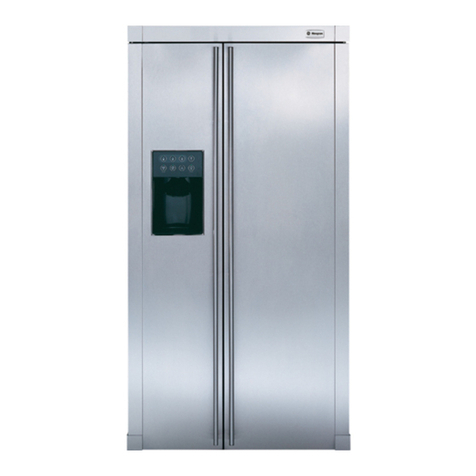
Monogram
Monogram Monogram ZFSB26DRSS Dimensions and specifications
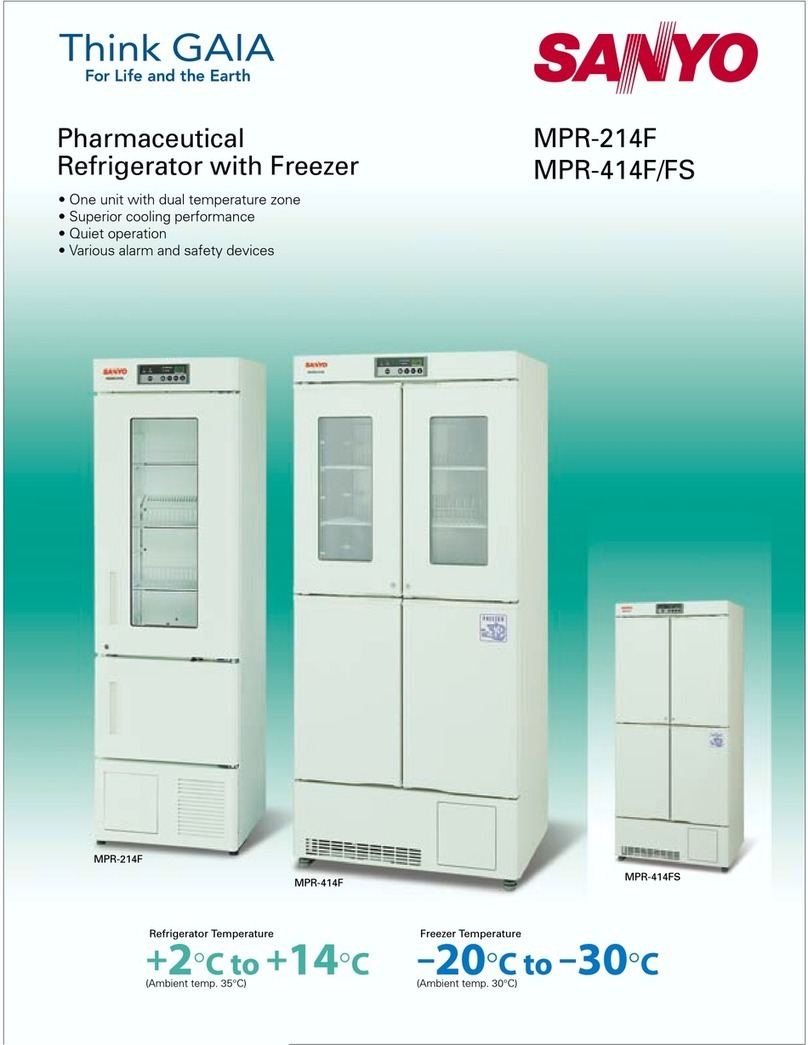
Sanyo
Sanyo MPR-414FS Specifications

AEG
AEG SANTO 2733-6 i Operating and installation instructions
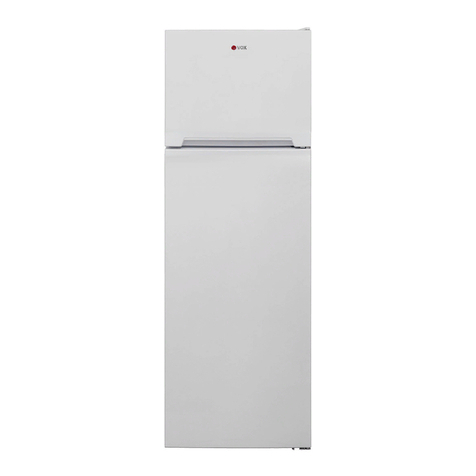
VOX electronics
VOX electronics KG3330 operating instructions

hestan
hestan GRWGR24YW Use & care manual
